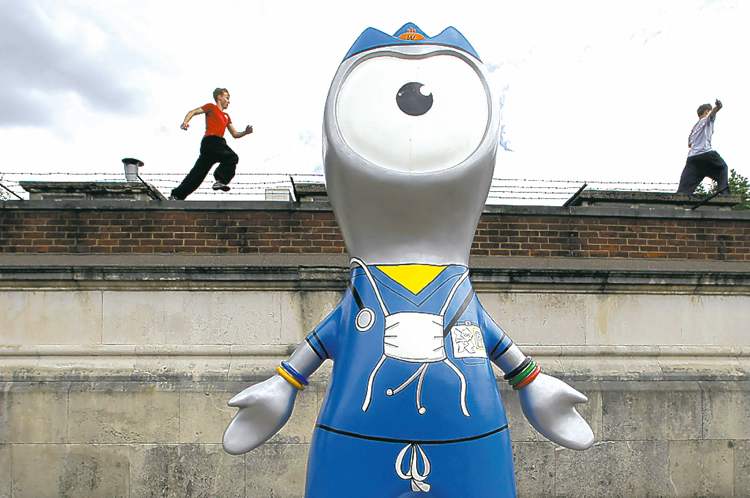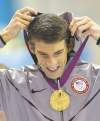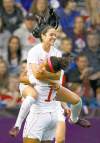Faster, higher, weirder
London Games' mascots sorta cute, kinda creepy and not easily understood
Advertisement
Read this article for free:
or
Already have an account? Log in here »
To continue reading, please subscribe:
Monthly Digital Subscription
$1 per week for 24 weeks*
- Enjoy unlimited reading on winnipegfreepress.com
- Read the E-Edition, our digital replica newspaper
- Access News Break, our award-winning app
- Play interactive puzzles
*Billed as $4.00 plus GST every four weeks. After 24 weeks, price increases to the regular rate of $19.00 plus GST every four weeks. Offer available to new and qualified returning subscribers only. Cancel any time.
Monthly Digital Subscription
$4.75/week*
- Enjoy unlimited reading on winnipegfreepress.com
- Read the E-Edition, our digital replica newspaper
- Access News Break, our award-winning app
- Play interactive puzzles
*Billed as $19 plus GST every four weeks. Cancel any time.
To continue reading, please subscribe:
Add Free Press access to your Brandon Sun subscription for only an additional
$1 for the first 4 weeks*
*Your next subscription payment will increase by $1.00 and you will be charged $16.99 plus GST for four weeks. After four weeks, your payment will increase to $23.99 plus GST every four weeks.
Read unlimited articles for free today:
or
Already have an account? Log in here »
Hey there, time traveller!
This article was published 04/08/2012 (4831 days ago), so information in it may no longer be current.
Every two years, the Olympic Games use rituals, symbols and truckloads of trademarked swag to showcase the host country’s culture, a process that inevitably leads to musings about “national character.”
The idea of national character is now mostly discredited, and rightly so. Still, it’s hard to get away from the idea that the 2012 Olympics have become one enormous celebration of British eccentricity. Just take the London Olympics’ seriously strange mascots, Wenlock and Mandeville.
Yes, the London Olympics’ tone was set by the extravagantly nutty opening ceremonies. Seemingly designed to perplex non-British TV commentators, the pageant included a visual history of the Industrial Revolution, a musical homage to the National Health Service, a spooky giant baby, and the Queen doing sketch comedy.

But director Danny Boyle’s big show had a crazed genius. The mascots are just crazy.
You can argue that all mascots, by their plushy, huge-headed nature, are destined to be weird. (Or even eerie. My interest in mascot issues partly tracks back to a traumatic encounter between one of my kids and a guy in a lobster suit at the Teddy Bears Picnic.) Wenlock and Mandeville are peculiar even by the peculiar standards of mascotry.
First of all, there are the names. Mandeville and Wenlock could be the new Defence Against the Dark Arts masters at Hogwarts, or perhaps minor Dickens characters. According to official explanations, Wenlock is named for a small Shropshire town that helped to inspire the modern Olympics games, while Mandeville refers to a hospital that held a 1948 athletic event for injured soldiers that eventually led to the Paralympics. Commendable histories both, but they require extensive footnoting.
Then there’s the look, which is also deeply perplexing. Supposedly the mascots are drops of metal, and according to their origin tale, they were formed from the last two bits of Bolton steel used for the girders in the Olympic Stadium. The lights on the top of their heads reference London’s iconic black cabs, while their blank one-eyed faces are supposedly digital cameras, taking everything in.
Again, nice ideas, but they take a helluva lot of explaining. As most designers and branding experts will tell you, that’s problematic.
Faced with these aggressively friendly, completely enigmatic walking cyclopes, people are making up their own stories. Media commentators got in first: The London mascots could be the product of “a drunken one-night stand between a Teletubby and a Dalek,” according to Globe & Mail columnist Tabitha Southey.
Meanwhile, an informal survey of random pedestrians on Jimmy Kimmel Live! suggests that the mascots are penises — happy, happy penises. (This is not an unprecedented association. Schuss, the mascot for the 1968 Grenoble Winter Olympics, was nicknamed “the skiing sperm.”)
However one reads the mascots, they seem to be riding that cute/creepy line, and riding it hard. Responding to media suggestions that the mascots might scare small children, London organizers insist that they are kid-friendly, what with their friendship bracelets and their iPhone visages and their love of social media. (Neither Mandeville nor Wenlock has a mouth, but they sure can Facebook and Tweet.)
Many grown-ups view those digital-age electronic eyes as sinister Orwellian reminders of 21st-century security cameras. “Welcome to London,” Wen and Mand seem to say. “You’re under surveillance.” Again, officials counter by saying that the mascots’ faces are a metaphor: The one eye suggests how we all see the Olympics together, united in the universal ideals of athletics.
Even the Internet conspiracy theorists are getting in on the debate. Some believe that Mandeville and Wenlock are satanic tools of the Illuminati, giving a jolly, shiny look to the occult society’s bid for a New World Order.
I don’t know that I’d go quite that far. Global domination seems a bit beyond the mascots’ mediocre, molten, big-bottomed scope. But I would say that as official reps of the Olympic Games, Mandeville and Wenlock are very, very odd.
And not in a good British way. Just in a sad, bad-design way.
alison.gillmor@freepress.mb.ca

Studying at the University of Winnipeg and later Toronto’s York University, Alison Gillmor planned to become an art historian. She ended up catching the journalism bug when she started as visual arts reviewer at the Winnipeg Free Press in 1992.
Our newsroom depends on a growing audience of readers to power our journalism. If you are not a paid reader, please consider becoming a subscriber.
Our newsroom depends on its audience of readers to power our journalism. Thank you for your support.









